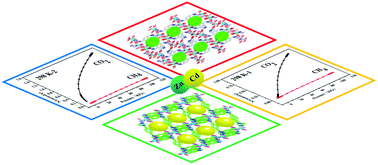Two metal–organic frameworks based on a flexible benzimidazole carboxylic acid ligand: selective gas sorption and luminescence†
Abstract
Two new three-dimensional (3D) porous metal–organic frameworks (MOFs), {[Cd2(L)(NMP)(H2O)2]·2H2O}n (1) and {[Zn(L)0.5(H2O)]·NMP·H2O}n (2), have been solvothermally synthesized by using Zn(II) and Cd(II) ions with H4L (H4L = 1,4-di(5,6-bicarboxylbenzimidazol-lylmethyl)benzene) in different ratios of H2O and NMP (NMP = 1-methyl-2-pyrrolidinone) solvents, all of which have been characterized by elemental analysis, FT-IR spectroscopy, powder X-ray diffraction (PXRD), and thermogravimetric analysis (TGA). As revealed by structural analysis, the H4L ligand took different coordination fashions in 1 and 2, and as a result, two MOFs with a novel (3,4,7)-connected trinodal net and (3,6)-connected binodal net were obtained, respectively. The structure comparison reveals that the coordination modes of ligands and the types of metal ions play decisive roles in regulating the final networks of MOFs. The desolvated frameworks 1 and 2 possess polar channels decorated with uncoordinated carboxylate groups, leading to an excellent ability to attract CO2 as well as significant adsorption selectivity for CO2 over CH4 at 273 and 298 K. Solid state 1 and 2 show blue photoluminescence.



 Please wait while we load your content...
Please wait while we load your content...